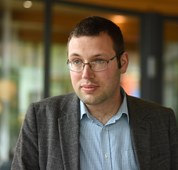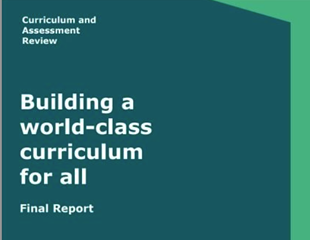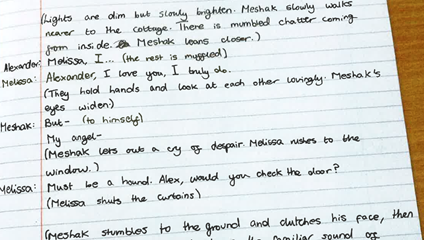One of our key areas of focus as EMC Associate Teachers has been developing students’ authentic responses to texts. I have found a range of approaches championed by the EMC helpful when exploring this, including offering students a choice of tasks and the use of journals to prioritise personal response, something which can easily get lost amidst overly formulaic approaches to textual analysis.
The A Level NEA provides a particularly powerful opportunity to maximise student choice and autonomy in responding to texts. For instance, Edexcel’s A Level English Literature NEA gives students entirely free choice of which two texts to compare. Our approach is to have one core text which the whole class studies together, and then for students to choose their second comparative text with some teacher guidance. This year, I decided to give further agency to the class by allowing them to choose from an initial shortlist of three texts. After reading the openings of each text and some further contextual information, the overwhelming majority voted for Brotherless Night, V. V. Ganeshananthan’s heart-rending novel about a young female medical student’s experiences during the Sri Lankan Civil War which won the 2024 Women’s Prize.
I was delighted by the students’ choice - when I re-read the novel, I was reminded of its compelling plot, nuanced characterisation, beautiful prose and above all its sense of moral complexity and urgency. I first approached the novel with very limited knowledge of the Sri Lankan Civil War but Ganeshananthan lays bare the history of this conflict with great clarity and, it seemed to me, even-handedness. This is both an examination of one specific war and of wars in general and their effects on individuals, communities and families. In my view, it comfortably stands alongside other popular novels about war from previous decades which have commonly been studied at KS5, such as Atonement, The Kite Runner and Birdsong. It perhaps goes even further than many of these novels in terms of the searching moral questions it asks: what is a terrorist and who gets to decide this? Can violence ever be justified by political oppression? What does it mean to ‘do no harm’ in a time of devastation and destruction?
Our study of this novel acquired additional significance as two students from the class are of Sri Lankan heritage, and were excited to start studying it. Their deep knowledge of Sri Lankan history and culture has proved a tremendous asset to our exploration of the novel: one student prepared immensely helpful notes on each chapter of the novel, including glossaries, timelines and maps where relevant to illuminate details within the text, and the two students also asked to give a presentation to the class about the Sri Lankan Civil War. This, too, was hugely valuable for the whole class - contrary to pedagogical frameworks which position the teacher as the expert and students as novices, my knowledge of this history, even with the aid of detailed research, would never match theirs so it would be ridiculous for me to attempt to impart the knowledge that I had developed to these students.
If we had not been fortunate to have these two students in the class, we would still have managed to access the novel: because Ganeshananthan is writing at least in part for a Western readership, the novel itself explains much of what we need to know and understand about its context. But their contributions have added immeasurably to our personal connection to the text and our understanding of specific nuances and sensitivities that only lived experience can illuminate.
This does not mean that teacher expertise is irrelevant, but it might take different forms; in our discussions I have been able to complement these students’ contextual explanations with insights about how historical fiction works as a genre, about formal and structural elements of the novel, about intertextual allusions and plenty more besides. But recognising that the students are not coming to the novel as empty vessels has allowed for much richer discussions around the novel.
This has also been reflected in students’ writing about the novel. They read the novel independently before we started studying it, but I have asked them to keep a journal as we re-read and discuss it, writing short reflections on what they have found most interesting or significant about each chapter. Usually they will complete this before we discuss the chapter in class, and I will look at their entries (which they upload to Google Classroom) before our lesson to help guide the discussion, often sharing extracts from different students’ responses with the whole class as a starting point.
What consistently strikes me about their writing is how different and original their comments are, unlike many assessments in English which can lead to most students saying very similar things about texts. Here, for instance, is a selection of different responses to Chapter 1 which preceded our discussion of this chapter in class:
Student 1
When I first read ‘Brotherless Night’ I noticed that VV Ganeshananthan had literally translated Tamil phrases to English and littered these across the whole novel. I was reading aloud and found that in my head I could see exactly how it would be said in Tamil. I thought it was interesting because she repeatedly stresses that the story is in english for the readers benefit, because it is the language they know, but that the characters in the book were Tamil. Despite this it is not just the dialogue that sounds tamil, it is also word order and her choice of expressions. I even read it to my mother in english first to see if she would hear it too, and she got extremely emotional because it sounded so familiar. I also thought the family dynamics were stereotypical of those portrayed in south asian family tv shows or novels. Sashi walking to the library with her brother, the shared worry for Dayalan when he comes home late, Sashi saying it's him they can't lose and Niranjan coming home and going to the temple with his sister. These tender demonstrations show the fondness that they have for each other, and, as the title is ‘Brotherless Night’, their familiarity with each other foreshadows an impending catastrophe.
Student 2
Throughout Chapter 1, Ganeshananthan’s lexical choices focus on the body and physicality. For example, the men in Sashi’s family are observed to be ‘tall and solid,’ ‘sturdy’ and ‘skinny’, with their physical presence correlating to their familial role, while K is primarily described by his face, creating a more intimate portrait. By describing his ‘thin, sensitive’ face and ‘lovely and old’ eyes, Sashi makes sense of her attraction to K by focusing on tangible biological features. Interestingly, Sashi’s awe for K and for medicine are intertwined, creating a blurred line in her attractions to the two. Later the ‘slumped shoulder’ of a smashed, burnt tea stall introduces a new aspect of the bodily semantic field: Sashi relies on her understanding of the body’s physicality to process an increasingly volatile world. Beyond the subtle lexical choices, Sashi’s reverence for the ‘mechanisms of living’ are more overtly explored in the innocent, feminine, artistic description of the ‘lacework’ of veins and the ‘soft, fragile balloons’ of lungs that she discovers in dissection. Medicine is not solely scientific but also spiritual.
Student 3
The motif of medicine and medical intervention is prominent throughout, shown especially through the healing of Sashi’s wound by K and the dissection of the shark head. There is a very intriguing symmetry between the nature and healing of Sashi’s wound and K’s death. Sashi’s wound is the consequence of a quick accident, the spilling of hot water, causing acute damage. Conversely, K’s death is the consequence of a torturous period of fasting, and arguably also caused by the years of military service. While Sashi’s wound is reversible, and hidden to everyone but K, K’s death was a public display of defiance with political motives, irreversible. Sashi’s reversible and healed wound at the start of the novel reflects the state of Sri Lanka at the start – still salvageable, and could be ‘healed’ with proper governmental rule. K’s irreversible death symbolises how Sri Lanka, at that point of the novel, is damaged beyond repair. Moreover, another interesting use of the medical motif is the dissection of the shark head. Ganeshananthan describes how Sashi has to ‘display its intricate nervous system’ in the dissection and only had one chance, or else she would have to practice with the ‘dainty, ruined head.’ On the surface this may just seem like a plot device to deter Sashi from entering medical school on the first attempt when she is presented with the shark head during her examination. However, it could harbour a more ominous message. The shark head could be a symbol of the political movement damaging those who participated in it, who displayed their thoughts and opinions (the ‘nervous system’) but were maimed in the process, ruined by the harsh and often violent movement. And once the individual has been dissected/cut open, incorrectly, by the political movement, the change is irreversible. The individual will forever have a ‘dainty, ruined head’. Over the course of this novel we see these ‘shark heads’ – K, Nirajan, Dayalan, Seelan slowly dissected by the political movement, until they are unrecognisable versions of themselves.
Student 4
Chapter 1 is very effective in introducing the tension between youthful ambition and the rising threat of violence at such an unstable time for a ‘normal’ family- a normal family with which we as readers can easily relate to. Sashi’s dream of becoming a doctor- embodied in the symbolic gift of Anna-akka’s stethoscope- represents a hope for healing and empathy in the world. Knowing that Sashi holds on to this altruistic desire to help others in terms of medicine and later through her involvement in spreading awareness in the writings of the Reports presents a refreshing sense of reliability and consistency which we struggle to find in the environment the characters find themselves in. The routine of Sashi and her brothers preparing for exams again allows Ganeshananthan to scatter moments of normalcy amidst the harrowing turbulence of an emergence of violence. When they’re studying they feel safe and united; “all three of us went to the library to review notes for the theoretical exams”. Yet in between these accounts of ordinary teenage existence we hear the rise of local attacks such as the Jaffa town hall shooting. This contrast is striking and saddening especially as we feel the characters urgently trying to find comfort in studying for exams and access their futures whilst they feel the path of their lives becoming increasingly indefinite. I also found the repeated mentions of news reports about missing Tamil boys especially powerful- they act almost like distant warnings which quickly close in and invade Sashi’s life. It’s a transition she’s at this stage only mildly aware of, as for me the tone in this chapter is relatively calm and informative compared to the more emotionally tense tone that is developed later on in the novel (particularly as the conflict causes the loss of so many of Sashi’s loved ones). Overall Chapter 1 captures the vulnerability of ordinary lives which are about to be torn apart by events beyond their control- no matter how hard they fight this fact.
Student 5
The vivid description of Sashi’s childhood memory and family life is what I find the most significant in this chapter, which only makes the disrupted normalcy portrayed at the end of the chapter more heart wrenching and poignant: Seelan and K ‘laughing, gesturing at each other wildly and lowering their brows as though they are giving great speeches’ when imitating the teacher they ’respected and liked’ has a calm before the storm feeling to it. Their conversations about their future aspirations are depicted in a youthful and innocent manner, most significantly Sashi’s declaration of her wanting to ‘be like my(Sashi’s) grandfather, helping anyone who needs it’ - which, right after we see the famous motto ‘First do no harm’ being quoted for the first time. This dialogue is written without quotation marks and structured in a single paragraph, which reinforced the fact that it was a snippet of important memory and the fragility of the relationship between people close to each other before they are broken apart by the conflict; the scene of the burning of the Jaffna library is intensely delineated by imageries such as ‘white walls blacken and fall into each other like so many dominoes’. The noun ‘dominoes’ not only represents the uncontrollable chain of events and the escalating resentment between political groups - it also shows the insignificance of the Jaffna civilians in the face of political unrests, as most painfully summed up in the last line of this chapter: ‘there are people in our country who would burn what we love and laugh at the flames.’
These all come from students’ initial responses to what they have read with very limited input from me, and the range of insights is fascinating. Student 1 draws on her knowledge of Tamil language to illuminate Ganeshananthan’s writing style and presentation of family life. Students 2 and 3 use analytical approaches learnt at GCSE to explore lexical choices, semantic fields and motifs but move beyond this to offer more critical reflections on the novel’s concerns - for instance that ‘medicine is not solely scientific but also spiritual’ or that Sashi’s brothers are ‘slowly dissected by the political movement, until they are unrecognisable versions of themselves’. And students 4 and 5 offer more of a personal response to the novel, considering their experiences as readers as they describe what they find ‘refreshing’, ‘harrowing’, ‘saddening’, ‘heart wrenching’, ‘poignant’ and ‘painful.’
In their different ways, these responses all embody the attentiveness, sensitivity and engagement which we want our students to develop as critical readers. This is important in all parts of the English curriculum, but particularly for the NEA where students will be responsible for choosing their own line of inquiry. An open rather than prescriptive approach at this stage should help them to identify particular areas of interest which they wish to pursue further.
The next stage of the NEA will allow further opportunities for students to develop their authentic responses as they choose a text with which to compare Brotherless Night. I am encouraging them to read a few possibilities before deciding. They may wish to deepen their exploration of the Sri Lankan Civil War by choosing a novel such as Shehan Karunitilaka’s The Seven Moons of Almeida or Anuk Arudpragasam’s A Passage North. Or they might look at how similar themes are presented in a different conflict, such as the 1974 invasion of Cyprus in Elif Shafak’s The Island of Missing Trees or the siege of Sarajevo in Priscilla Morris’s Black Butterflies. If they are particularly interested in the impact of war on women then novels such as Lucy Caldwell’s These Days or Maaza Mengiste’s The Shadow King would allow them to make fascinating connections. They might look at another post-9/11 novel which interrogates the concept of terrorism such as Kamila Shamise’s Home Fire or Mohsin Hamid’s The Reluctant Fundamentalist. And some students may choose a text which resonates with their own heritage, such as Chimamanda Ngozi Adichie’s Half of a Yellow Sun about the Biafran War, Madeleine Thien’s Do Not Say We Have Nothing set during the Chinese Cultural Revolution or Pakistani-American poet Fatimah Asghar’s collection If They Come For Us, about the legacy of Partition. Whatever they opt for, the approaches they have adopted when studying Brotherless Night should equip them to respond with insight and originality to their second text.






